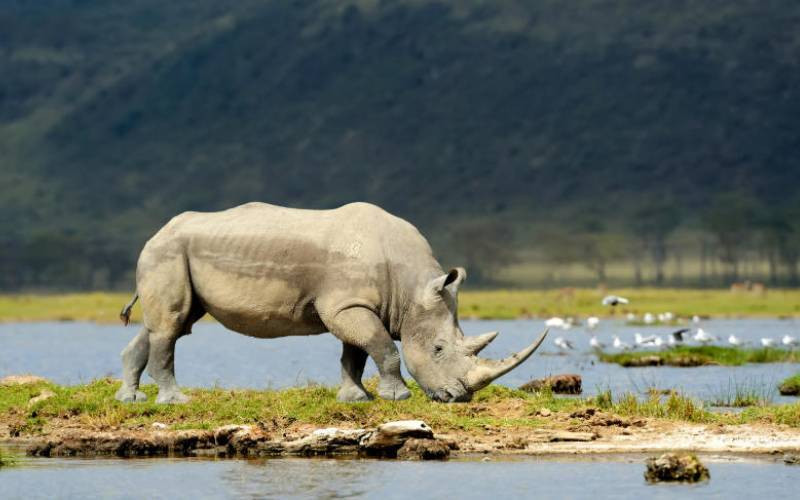NAIROBI: Tuesday, March 3, was World Wildlife Day, when the world paused to celebrate the astonishing diversity of fauna and flora on this planet, and reflect on the challenges they face.
You may ask why the United Nations chose in late 2013 to establish this new day of commemoration. After all, surely everyone is now well aware of the many threats to wildlife? To a certain extent, this is true.
But, regrettably, the extent of humanity's negative impacts on species and their habitats is still not fully appreciated. And global action to conserve species, including such iconic creatures as the African elephant, is yet to hit the level required to ensure these treasures of the natural world will enrich our lives for generations to come.
Despite growing awareness and action, the statistics make for grim reading. Some 20,000 to 25,000 elephants are killed each year in Africa. This is leading to an inevitable decline from years gone by, when massive herds roamed the savannahs and forests of the continent.
The Convention on International Trade in Endangered Species of Wild Fauna and Flora (CITES) reported that in 2014 alone, 1,215 rhinos were poached in South Africa. This translates to one rhino killed every eight hours.
The illicit traffic in live great apes is an increasingly serious threat to chimpanzees, gorillas, orangutans and bonobos in Africa and Asia. Latest estimates indicate a minimum of 220 chimpanzees, 106 orangutans, 33 bonobos, and 15 gorillas have been lost from the wild since 2014. Since 2005, the overall loss rate is likely to be in excess of 22,000.
Finally, there are only 80 Spix's macaws left in the world, the majority of which are kept by foreign bird keepers—which is why two of the birds will arrive in Sao Paulo today as part of a programme to return this species to its original Brazilian habitat.
Much of this species loss is driven by one of the oldest, and worst, human motivations: profit. Global environmental crime is worth up to US $213 billion each year, and helps finance corruption, crime, conflict and civil strife.
Not only does this trade decimate wildlife populations, it puts money in the pockets of groups who threaten the security and sustainable development of many nations.
We know the scale of the problem, and we have a responsibility to ensure the world knows it too. Everybody has a duty to do what they can, at every level of society, to halt the decline. The good news is that progress has been made on many levels.
In early 2014, China crushed 6.2 tonnes of illegal ivory — the first time this key destination country has done so. Many other nations have destroyed ivory stocks. Kenya, of course, burned stockpiles in 1989 and 2011, and plans to do so again. Destroying ivory does not, of course, end the illegal ivory trade. But it sends a clear signal that it will no longer be tolerated.
Enforcement is also improving. In the same month that China burned its ivory, Kenya began a crackdown on poaching, handing down a custodial sentence to a man caught smuggling an ivory tusk through Nairobi.
Operation Wildcat in East Africa — which involved authorities from five countries — resulted in 660 arrests and the seizure of 240 kg of elephant ivory.
These successes prove we know what needs to be done. We must reduce demand for illegally traded wildlife by ensuring that consumers understand the link between the products they buy and the wholesale slaughter or enslavement of wildlife.
We must expose the criminal groups in source, transit and destination countries. We must ensure communities understand their long-term prosperity can actually improve should they conserve species, and thus the tourism revenues they bring.
Stay informed. Subscribe to our newsletter
Ultimately, we are all in this together, and only collective action will halt the shameful trade.
 The Standard Group Plc is a
multi-media organization with investments in media platforms spanning newspaper
print operations, television, radio broadcasting, digital and online services. The
Standard Group is recognized as a leading multi-media house in Kenya with a key
influence in matters of national and international interest.
The Standard Group Plc is a
multi-media organization with investments in media platforms spanning newspaper
print operations, television, radio broadcasting, digital and online services. The
Standard Group is recognized as a leading multi-media house in Kenya with a key
influence in matters of national and international interest.
 The Standard Group Plc is a
multi-media organization with investments in media platforms spanning newspaper
print operations, television, radio broadcasting, digital and online services. The
Standard Group is recognized as a leading multi-media house in Kenya with a key
influence in matters of national and international interest.
The Standard Group Plc is a
multi-media organization with investments in media platforms spanning newspaper
print operations, television, radio broadcasting, digital and online services. The
Standard Group is recognized as a leading multi-media house in Kenya with a key
influence in matters of national and international interest.






